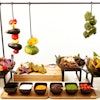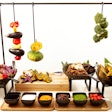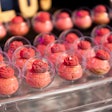
Will Goldfarb of Room 4 Dessert's stack of raspberry jellies, grapefruit timbale with elderflower, raspberry sorbet push-pop, and chocolate fudgesicle.
Photo: Marina Fragoso Senra for BizBash
Is a steak just a steak when it’s been glazed with beef fat that’s been clarified in a centrifuge machine? Is cake still dessert when it’s made with pancetta? These days, when you order at certain new restaurants, what arrives on your plate doesn’t necessarily look (or taste) like what you expected. And that feeling of surprise and discovery is exactly what the chefs devising these dishes want you to experience. Sometimes that impulse stems from the risk involved in serving a meal that can shock—or repulse—diners. Sometimes it’s about taking a fresh approach to a classic dish or ingredient. But whatever the end result, this moment in the food world is all about experimentation and pushing boundaries.
So how does this translate to events? This week, we're addressing that question with a series of stories from the latest issue of our magazine. We'll be posting Q&As with cutting-edge chefs, guides to using in-vogue ingredients, and a look at new ideas from caterers across the country.Translating unique cuisine for mass quantities may not always work—especially when, in some cases, executing a recipe seems to require an advanced chemistry degree. And considering the event-world maxim that party guests want to eat things they recognize, hosts and caterers typically avoid the confusion that comes from encountering a tray of puzzling canapés.
But—of course—event food can still be innovative. And guests who thrill to surprising restaurant experiences can still find new forms and flavors at parties. A bowl of soup becomes a lollipop, fish gets cooked and presented in a plastic bag, a piece of chocolate looks more like jewelry than dessert. So we hope you'll check out our look at the chefs, ingredients, concepts, and techniques on the cutting edge of food.
So how does this translate to events? This week, we're addressing that question with a series of stories from the latest issue of our magazine. We'll be posting Q&As with cutting-edge chefs, guides to using in-vogue ingredients, and a look at new ideas from caterers across the country.Translating unique cuisine for mass quantities may not always work—especially when, in some cases, executing a recipe seems to require an advanced chemistry degree. And considering the event-world maxim that party guests want to eat things they recognize, hosts and caterers typically avoid the confusion that comes from encountering a tray of puzzling canapés.
But—of course—event food can still be innovative. And guests who thrill to surprising restaurant experiences can still find new forms and flavors at parties. A bowl of soup becomes a lollipop, fish gets cooked and presented in a plastic bag, a piece of chocolate looks more like jewelry than dessert. So we hope you'll check out our look at the chefs, ingredients, concepts, and techniques on the cutting edge of food.



















